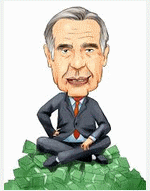5 CHARTS THAT WILL KEEP YOU IN PEACE AND NOT IN PIECES DURING THE WEEK AHEAD
click chart to enlarge
THE ASTOUNDING SIMILARITIES BETWEEN FACEBOOK AND YAHOO POST-IPO: PART 4
The counter-intuitive nature of the markets is one component of speculation that is without dispute. Human intuition is an asset in many situations we face on a daily basis. However, in the markets, it is a tool that investors use to deceive themselves into and out of positions they have no business being in, around or near. Our natural intuition or tendency as people is to want an explanation for not just some things, but for everything. This want has proven beneficial to consistent progress of humankind. Even when things are inexplicable, we tend to make up explanations that allow us to rationalize the situation, whether supernatural, spiritual or otherwise. That want of an explanation for everything that occurs transfers into the financial markets, as well. There are certain things that simply can't be explained. In fact, the need for an explanation inhibits the ability of the investors to profit from the situation. The most profitable opportunities in the markets are always those seem absolutely crazy because they fail at logical explanation. To take that one step further, it is often times the most logical investment thesis that will fail miserably because it attracts a consensus of intuitively driven investors who only choose to view the landscape in black and white without looking at the vast contrasts of grey that surround them. The relationship between FB and YHOO some 18 months following their IPOs fails explanation. It is, however, something I have been following since only a few months after FB came public. It started with the not so subtle headline of Facebook Is The Next Yahoo And That Makes It Very Bullish in August of 2012 when FB was trading at 20. In September I followed up with The Astounding Similarity Between The Yahoo IPO and Facebook IPO Continues To Be...Astounding in September. Part 3 of this study was posted in November with article titled The Facebook IPO in 2012 And The Yahoo IPO in 1996 Continue Their Strange Relationship. Now we have this...and it just gets more bizarre in the similarities as each month passes: click chart to enlarge What makes this study all the more plausible is the fact that we are following a very similar path as the market did from 1995-2000, when YHOO initially flourished. This is another study, although more macro-related, that has come in multiple parts over the past 12 months, the most recent of which was outlined here just this past week. The confluence of events that suggest FB is not just going higher, but much higher is simply too great to ignore. The question of what happens next can probably be...
PORTFOLIO UPDATE: A SLIGHT ADD
During the trading day, I tweeted the following: I've expressed my affinity for regional bank shares many times over the past 12 months. It is not so much that these names have tremendous, instantaneous upside due to a misinterpretation of future growth potential. These are, after all, old economy companies with a very defined pattern of top and bottom line growth. Their businesses are dependent on local economies. It is regional labor growth and the subsequent resulting growth in both commercial and residential real estate that creates prosperity at companies like SBCF. What is special about regional bank names at present is the fact that the downside is so very well defined. The balance sheets of these companies, in most cases, are now back to pre-crisis levels of prosperity. The net losses are slowly turning into consistent quarterly profitability. SBCF, as an example, announced just yesterday that they are no longer subject to government oversight for the first time since 2008. Their balance sheet is now considered "well capitalized." This allows the company to become more aggressive in their operations as they seek to increase profitability over the coming quarters. In the meantime, the company has barely been rewarded for its increased health. The stock price is only slightly above its 2012 highs, when the future of the real estate market and regional economies throughout the country was much more murky than it is now. This creates an opportunity that is very low risk in a general market environment that has become exponentially more risk-laden since that start of 2013. By "risk-laden" I don't mean that the markets are prone to collapse by next Wednesday. What I mean is that risk/reward opportunities where you were exchanging say 1 unit of risk for 6 units of reward are no longer available. You now have to settle for much less reward with much greater risk. SBCF presents the kind of compelling lack of downside risk that makes it a no-brainer type of investment at these levels. It just requires patience as they aren't going to announce a buzz-worthy mobile advertising initiative in the next few months that is going to potentially triple revenues by 2015. At best, a guy from Tallahassee will want to finance his boat through Seacoast Bank while maintaining a $50,000 CD. In other words, it is not going to be a barn burner to the upside, but a slow and steady gainer over the next several years. As it stands today, the portfolios consist of WMIH, CIDM, HMPR, SBCF and EVOL. A tight...
THE DOW OF 1995 IS PROVIDING A PERFECT ROADMAP FOR THE REST OF 2013
Over the past couple years, I have presented numerous bullish studies that have pointed to a rally that is on par with what we saw during 1982-1987 and 1995-2000. Both of these were 5 year rallies that presented significant technical clues as they were getting started. The technical clues were focused around trajectory points. For those of you who have been following along for the past few years, trajectory points along with volume are the only technical tools I use to gauge price. Simply put, a trajectory point is a means of gaining perspective into price. There was a scene in the movie "The Aviator" where Howard Hughes was making "Hell's Angels." During the initial filming he was disturbed by the fact that the planes looked like they were moving slowly or not at all against a clear sky. It was only when he filmed the scene against a backdrop of clouds that viewers were able gauge how quickly the planes were actually maneuvering. Trajectory points are essentially the clouds that allow market observers to gauge how quickly the market is moving. Without them you have no reference point from which to measure movement. Where I was incorrect in the past study of the 1987-1995 market was where the market was in relation to breaking away from the trajectory. When I posted this chart in October 2012, I was expecting the market to begin accelerating away from its key trajectory point in 2015 based on where the Dow was relative to the 1987-1995 roadmap. Instead, it started its acceleration this year. What I think is important to pay attention to at present is the behavior of the Dow as it pulled away from its trajectory point in 1995. This is the exact same trajectory we are pulling away from at present. I am posting monthly charts to give a clearer picture of what has occurred as well as what to expect. The first chart is a long-term view of the trajectory point dating back to 1995 for reference: click chart to enlarge The second chart is the 90s Dow versus the current Dow as they accelerate away from the same trajectory after hugging it in the previous years. Many striking similarities as noted in the...
PORTFOLIO UPDATE: A SLIGHT TRIM
During the trading day, I tweeted the following: On Friday, I said that the 10 level was the most significant level of resistance EVOL will face during this uptrend. The reaction to the level had enough downside velocity attached to it that it caused me to cut the position in half following a nice two and a half month profit in the stock. There is also that little issue of the market being in an unpredictable, reactive phase right now as it attempts to digest the upside we have seen throughout September. A slight bit of defense certainly isn't a bad thing here. As of the close today, the portfolios consist of WMIH, HMPR, EVOL and CIDM. There is one more name that I have been accumulating and will be announcing before month end, as long as I have the shares I would like in place. Current allocation is 85% long and 15% cash. Per the usual, I will have a detailed discussion of the developments in each individual name during the month end performance summary due out next week. If you would like to be added to the monthly email list to receive a full PDF version of the performance summary, please email me at...
3 CHARTS THAT WILL HAVE YOU HOWLING ON THE NIGHT OF THE SEVENTH MOON DURING THE WEEK AHEAD
click chart to enlarge
REDEFINING EXPECTATIONS FOR THE PUT/CALL RATIO DURING SECULAR BULL MARKETS
Let's begin this post with what I think is an obvious presumption: We are currently in a bull market that is secular in nature. I base this presumption on a number of factors, most important is the simple fact that numerous important indices are posting consistent all-time highs. Without getting into the technical particulars (these are easy to find if you spend 20 minutes on this site), all-time highs in leading indices following an extended period of crisis, doubt and under-performance can generally be trusted to signify a bull market that is much more than cyclical in nature. If we accept this presumption, then we must also accept the fact of what a secular bull market entails at its core: An expansion of ranges for all available metrics. This is regardless of whether these metrics are technical or fundamental in nature. In other words, price/earning ratios form an expansive new range. Markets caps that were previously thought of as absurd become the new normal. Technical measurements of excess are rethought and reformed. The very nature of a bull market is rethinking what are acceptable measures of prosperity. With each new secular bull market this rethinking process has occurred, which eventually has led to instability due to the paradigm shift that takes the economy into places where protective legislative and corporate measures fail. We are far from this point, but the reason it is worth mentioning is to aide in conceptualizing how dramatic the shift in the pricing landscape (ranges in price) must be that it challenges the very structure of economy. Let's now use the aforementioned presumption in paragraph one and fact in paragraph two to look at a favorite measure for gauging sentiment. The put/call ratio is one of the most valuable tools to measure sentiment. There is one consideration, however, that investors fail to make during bull markets. The absence of this consideration creates false signals galore that dissuades investors from considering the put/call ratio as a bull market matures. The consideration is the fact that just as multiples, market caps and technical indicators will face an expansion in what is seen as normal ranges, so will the put/call ratio. This means that the measurement previously considered to be golden at picking tops for a bull run, will fail consistently as a market matures. As a bull market expands, so should an investors expectations of what is considered "extreme bullish sentiment." Let's look at a long-term chart of the combined put/call ratio using 20 & 100 day moving averages only, looking all the way back to 1995-present: click chart to...
QUICK THOUGHTS: BRINGING IT
- The Dow is sitting at a tremendously important point of resistance. This was the stopping point I illustrated in the weekly review on Sunday. We are sitting on it almost exactly. There is a bullish and bearish scenario of what can transpire from here. I will go over both on the weekly review this coming Sunday. - The leadership of the SOX continues to be a bullish indicator for the market. - The leadership of the Nasdaq also continues to be an extremely bullish indicator for the market. - Speaking of the Nasdaq...the NDX (Nasdaq 100) is up against a pretty significant generational trajectory point here. Historically it has led to sideways or down periods for a number of months. Doesn't necessarily mean that it will this time, however. Again, I will go over this one in the weekly summary on Sunday. - Transports breaking out is another positive that is certainly worth mentioning. - Hate to be a broken record, but let's not forget about how well the Russell 2000 is acting. Another leader that is doing exactly what it's supposed to be doing at the exact right time. - Everything from the symmetry of the market to the leadership of specific indices falls in place. It speaks of the general health of this market and portends future price increases throughout Q4. - Interesting how the talk of the low put/call ratio was such a topic last week and has disappeared with a higher market. As discussed last week, the put/call was the incorrect focus at the incorrect time. Texture is everything in the market. - Michael Bigger had a cool piece on his website today about leaving $20 million the table on PCLN over the past 10 or so years. I have discussed this subject numerous times in the past, but feel it is important enough to pound away at it regardless. The real gains in the market are made by sitting tight. The wisest and most experienced investors will tell you this over and over again. Jumping around in a bull market is a fool's game. Your universe of stocks should be small and your activity in that universe should be as blissfully inactive as...
3 CHARTS THAT WILL CREATE RIPPLES IN YOUR PORTFOLIO FOR THE WEEK AHEAD
click chart to enlarge
IS CARL ICAHN IN THE MIDST OF A BILL ACKMAN MOMENT?
Perhaps I am a cynic by nature? Perhaps I have been watching events on Wall Street transpire for too long? Or perhaps I realize that the market gods are a fickle bunch that turn their back on even the best of investors at the most public of times? Whatever this feeling I have regarding Carl Icahn and his love for AAPL is, I know that it is coming from a place where alarms naturally tend to sound whenever someone is so public, enthusiastic and popular in their opinion regarding a company that is so readily admired and adored. Icahn, it can be argued, is now at the pinnacle of his success. He is coming off of several outstanding years, in which he has posted well above average for his investors. He seems to be winning his mud wrestling match with Bill Ackman by being temporarily, at least, proven right on his HLF investment, much to the detriment of Bill Ackman's short position. More importantly, all of these successes have been extremely public in nature. He is confident to no end. And the market is giving his advice regarding potentially lucrative investments a warm massage and a serving of steak tartare, in the form of premiums that immediately come into the marketplace whenever mention is made of a Carl Icahn investment. With AAPL he has been especially public, taking to Twitter in order to communicate his enthusiasm. Using phrases like "no-brainer" to describe the AAPL investment, that in turn makes those who choose to follow Icahn into hormonal teenagers, clenching their hands together while crying beneath him in horn-rimmed eye glasses and velvet mini-skirts. AAPL is, arguably, the most popular public company out there today. And Carl Icahn is one of the most popular investors of our generation. This combination of the most popular company with one of the most popular investors feels much too much like Icahn's "I am a Greek god" moment. It has all the makings of a spectacular dive that has no choice but to go wrong. Just look at those who have recently come before Icahn in soiling themselves both in front of the public and often times on the public, as investors of all pedigree are only too happy to hop on the love train. John Paulson became a hero with subprime CDS. He was an investor that was to be followed. His form 13-F (for those of you unfamiliar, this is the SEC form that fund managers are required to file quarterly showing current holdings) became a biblical account of how one's portfolio should be structured. He subsequently falls flat into a sea...










